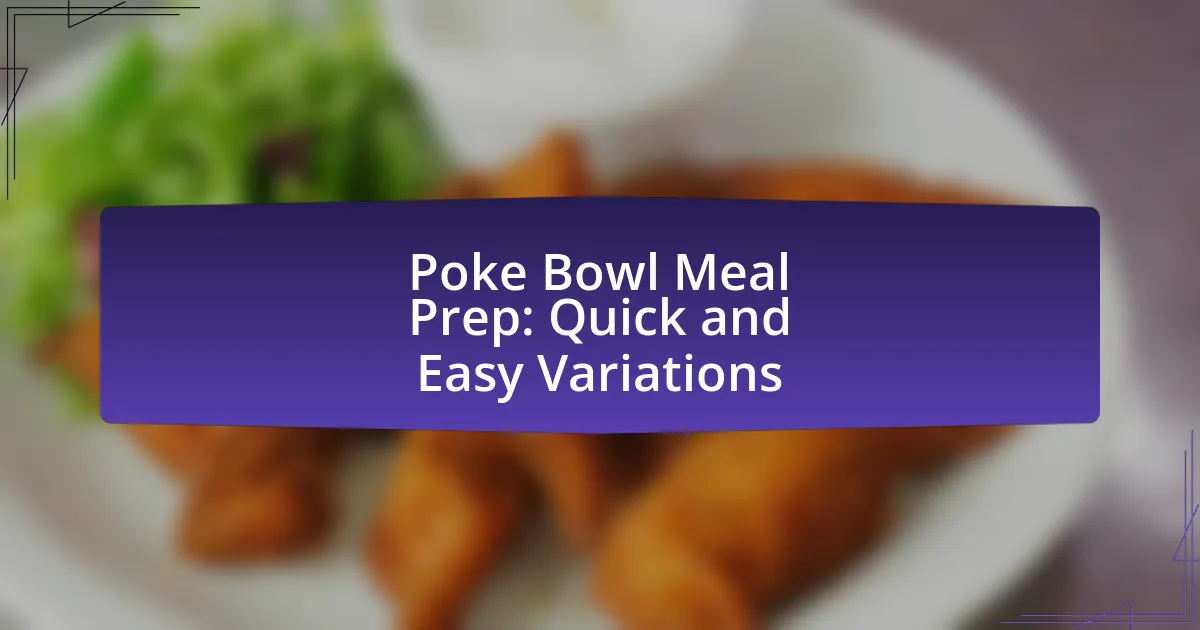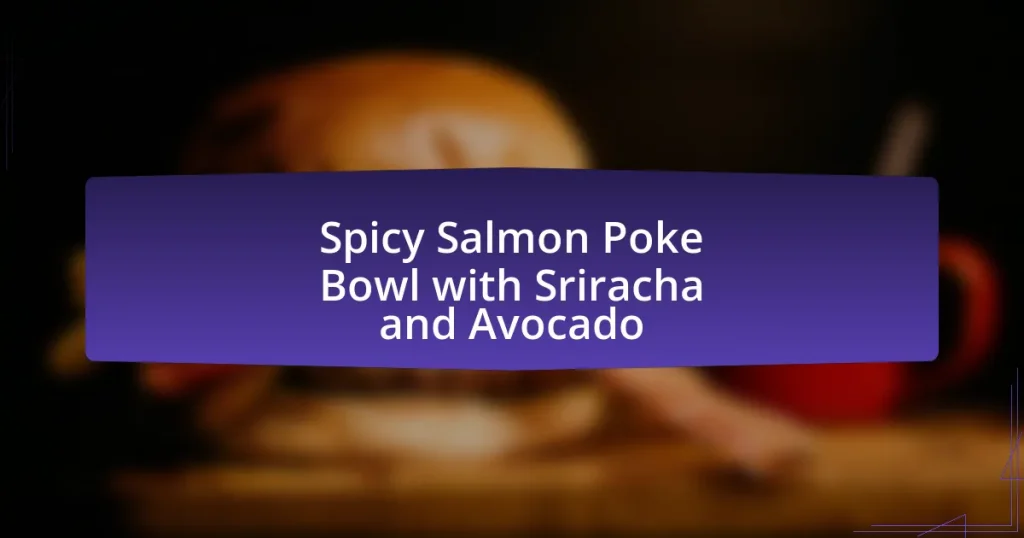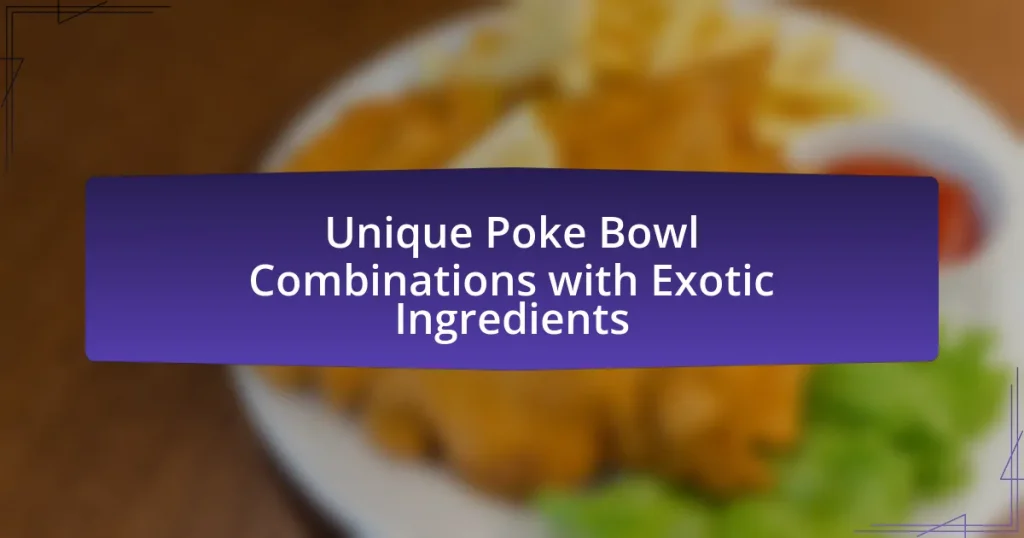Poke Bowl Meal Prep involves the advance preparation of ingredients for poke bowls, facilitating quick meal assembly throughout the week. Originating in Hawaii, poke bowls traditionally feature diced raw fish and have evolved to include various proteins, bases, and toppings influenced by Hawaiian, Japanese, and American cuisines. This article explores the importance of meal prepping for poke bowls, highlighting its nutritional benefits, time-saving aspects, and key components such as base options, proteins, and toppings. Additionally, it provides tips for customizing poke bowls to accommodate different dietary preferences, along with quick recipes and storage techniques to enhance the meal prep experience.

What is a Poke Bowl Meal Prep?
A Poke Bowl Meal Prep is the process of preparing ingredients for poke bowls in advance, allowing for quick assembly of meals throughout the week. This typically involves cooking and portioning proteins like fish or tofu, preparing base ingredients such as rice or salad greens, and chopping vegetables and toppings. Meal prepping for poke bowls can enhance convenience and ensure balanced nutrition, as it allows individuals to customize their meals with fresh ingredients while saving time during busy days.
How did Poke Bowls originate and evolve?
Poke bowls originated in Hawaii, where they were traditionally made with diced raw fish, typically tuna, seasoned with soy sauce and sesame oil. The dish evolved from a local fishing practice where fishermen would slice their catch into small pieces and season it for a quick meal. Over time, poke bowls expanded in variety, incorporating different types of fish, vegetables, and toppings, reflecting the multicultural influences in Hawaii. The rise of poke bowl restaurants in the mainland United States during the 2010s further popularized the dish, leading to diverse interpretations and customizable options that cater to various dietary preferences.
What cultural influences shaped the modern Poke Bowl?
The modern Poke Bowl is primarily shaped by Hawaiian, Japanese, and American culinary influences. Originating in Hawaii, poke features diced raw fish, a practice influenced by Japanese sashimi traditions. The incorporation of ingredients like soy sauce, sesame oil, and seaweed reflects Japanese flavors, while the adaptation of poke in mainland America has led to diverse toppings and variations, catering to local tastes and dietary preferences. This fusion illustrates how traditional Hawaiian poke has evolved through cultural exchange and innovation, resulting in the contemporary Poke Bowl enjoyed today.
What are the traditional ingredients of a Poke Bowl?
The traditional ingredients of a Poke Bowl include diced raw fish, typically tuna or salmon, served over a base of rice, often sushi rice. Additional components commonly found in a Poke Bowl are seaweed, avocado, cucumber, and various toppings such as sesame seeds and green onions. These ingredients reflect the dish’s Hawaiian origins, where fresh fish and local produce are staples. The combination of these elements creates a balanced meal that emphasizes freshness and flavor, aligning with traditional Hawaiian culinary practices.
Why is Meal Prep important for Poke Bowls?
Meal prep is important for poke bowls because it enhances convenience, ensures freshness, and promotes healthier eating habits. By preparing ingredients in advance, individuals can save time during busy weekdays, allowing for quick assembly of nutritious meals. Additionally, meal prepping helps maintain the quality of fresh ingredients, such as fish and vegetables, which are essential for the flavor and texture of poke bowls. Studies show that meal prepping can lead to better dietary choices, as it reduces the likelihood of opting for unhealthy fast food options when time is limited.
How does meal prepping save time during the week?
Meal prepping saves time during the week by allowing individuals to prepare and portion meals in advance, reducing daily cooking and cleanup time. By dedicating a specific time to cook and organize meals, individuals can streamline their weekly food preparation, leading to quicker meal access on busy days. Research indicates that meal prepping can cut down cooking time by up to 50%, as it eliminates the need for daily meal planning and ingredient gathering. This efficiency not only saves time but also promotes healthier eating habits by making nutritious options readily available.
What are the nutritional benefits of meal prepping Poke Bowls?
Meal prepping Poke Bowls offers significant nutritional benefits, including a balanced intake of macronutrients and micronutrients. Poke Bowls typically contain a base of whole grains, such as brown rice or quinoa, which provide complex carbohydrates and fiber, promoting digestive health and sustained energy levels. The inclusion of fresh fish, like salmon or tuna, contributes high-quality protein and essential omega-3 fatty acids, which are beneficial for heart health and cognitive function. Additionally, the incorporation of various vegetables, such as seaweed, avocado, and cucumbers, enhances the vitamin and mineral content, supporting overall health and immune function. Studies indicate that meal prepping can lead to healthier eating habits, as it encourages portion control and reduces reliance on processed foods, ultimately contributing to better dietary choices and weight management.
What are the key components of a Poke Bowl Meal Prep?
The key components of a Poke Bowl Meal Prep include a base, protein, toppings, and sauce. The base typically consists of rice or salad greens, providing a foundation for the bowl. The protein can be raw fish like tuna or salmon, or alternatives such as tofu or chicken, which are essential for flavor and nutrition. Toppings often include vegetables like avocado, cucumber, and radishes, as well as garnishes such as seaweed and sesame seeds, adding texture and color. Finally, a sauce, often soy sauce or a spicy mayo, enhances the overall taste of the dish. These components work together to create a balanced and flavorful meal, aligning with the traditional Hawaiian origins of poke bowls.
What base options can be used in Poke Bowls?
Poke bowls can be based on several options, including sushi rice, brown rice, quinoa, mixed greens, and cauliflower rice. Sushi rice is a traditional choice, providing a sticky texture that complements the toppings. Brown rice offers a whole grain alternative with added fiber. Quinoa serves as a protein-rich base, while mixed greens provide a fresh, low-carb option. Cauliflower rice is a popular choice for those seeking a low-calorie, vegetable-based alternative. Each base option enhances the overall flavor and nutritional profile of the poke bowl.
Which proteins are commonly included in Poke Bowls?
Common proteins included in Poke Bowls are raw fish varieties such as tuna, salmon, and octopus, as well as cooked options like shrimp, crab, and tofu. These proteins are foundational to the dish, providing essential nutrients and flavors. For instance, tuna and salmon are rich in omega-3 fatty acids, which are beneficial for heart health, while tofu serves as a plant-based protein alternative, catering to vegetarian diets.
What toppings enhance the flavor and texture of Poke Bowls?
Toppings that enhance the flavor and texture of Poke Bowls include avocado, seaweed salad, pickled ginger, sesame seeds, and scallions. Avocado adds creaminess, while seaweed salad contributes a briny flavor and chewy texture. Pickled ginger provides a sharp contrast, sesame seeds add a nutty crunch, and scallions offer a fresh, onion-like bite. These toppings not only complement the base ingredients but also create a balanced and satisfying dish.

What are some Quick and Easy Variations of Poke Bowls?
Quick and easy variations of poke bowls include using different bases such as quinoa, brown rice, or mixed greens instead of traditional sushi rice. Additionally, proteins can vary from raw fish like salmon and tuna to cooked options like shrimp or tofu. Toppings can include a mix of avocado, seaweed salad, edamame, and pickled vegetables, while sauces can range from soy sauce to spicy mayo or sesame dressing. These variations allow for customization based on dietary preferences and available ingredients, making poke bowls versatile and accessible for meal prep.
How can I customize my Poke Bowl for different dietary preferences?
To customize your Poke Bowl for different dietary preferences, select ingredients that align with specific dietary needs. For example, for a vegetarian option, use tofu or tempeh as a protein source, while for a low-carb diet, opt for cauliflower rice instead of traditional rice. Additionally, gluten-free soy sauce can replace regular soy sauce for those with gluten sensitivities. According to the USDA, incorporating a variety of vegetables and healthy fats, such as avocado or sesame oil, can enhance nutritional value while catering to diverse dietary requirements.
What are some vegetarian or vegan options for Poke Bowls?
Vegetarian and vegan options for Poke Bowls include tofu, tempeh, edamame, seaweed salad, and a variety of fresh vegetables such as cucumber, avocado, and radish. Tofu and tempeh serve as excellent protein sources, while edamame adds a nutritious touch. Seaweed salad contributes a unique flavor and texture, and the fresh vegetables enhance the bowl’s overall freshness and nutritional value. These ingredients collectively create a satisfying and balanced meal that adheres to vegetarian and vegan dietary preferences.
How can I make gluten-free Poke Bowls?
To make gluten-free Poke Bowls, use gluten-free ingredients such as sushi rice, fresh fish like tuna or salmon, and gluten-free soy sauce or tamari. Begin by cooking sushi rice according to package instructions, ensuring it is seasoned with rice vinegar, sugar, and salt for flavor. Next, prepare your choice of protein by slicing fresh fish into cubes. Assemble the bowl by layering the rice, fish, and toppings like avocado, seaweed, cucumber, and radishes. Drizzle with gluten-free soy sauce or a gluten-free dressing to enhance the flavor. This method ensures that all components are free from gluten, making the dish suitable for those with gluten sensitivities.
What are some quick recipes for Poke Bowl Meal Prep?
Quick recipes for Poke Bowl Meal Prep include a Salmon Poke Bowl, which consists of cubed salmon, sushi rice, avocado, cucumber, and a drizzle of soy sauce. Another option is a Tuna Poke Bowl, featuring diced tuna, brown rice, edamame, seaweed salad, and sesame oil. A vegetarian variation can be made with marinated tofu, quinoa, carrots, radishes, and a spicy mayo dressing. These recipes can be prepared in under 30 minutes and stored in the refrigerator for up to three days, making them ideal for meal prep.
How do I prepare a classic Ahi Tuna Poke Bowl?
To prepare a classic Ahi Tuna Poke Bowl, start by cubing fresh Ahi tuna into bite-sized pieces. Combine the cubed tuna with soy sauce, sesame oil, and chopped green onions in a bowl, allowing it to marinate for about 15 minutes. Serve the marinated tuna over a base of sushi rice, and top with sliced avocado, seaweed salad, and sesame seeds. This method is validated by traditional Hawaiian poke recipes, which emphasize fresh ingredients and simple preparation techniques.
What ingredients are needed for a spicy salmon Poke Bowl?
A spicy salmon Poke Bowl requires sushi-grade salmon, soy sauce, sesame oil, Sriracha, green onions, avocado, cucumber, and sushi rice. Sushi-grade salmon is essential for safety and quality, while soy sauce and sesame oil provide the base flavor. Sriracha adds the desired spiciness, and green onions, avocado, and cucumber contribute freshness and texture. Sushi rice serves as the foundation of the bowl, making it a complete meal.
How can I create a tropical fruit Poke Bowl?
To create a tropical fruit Poke Bowl, start by selecting a base such as sushi rice or quinoa, then layer it with a variety of tropical fruits like mango, pineapple, kiwi, and avocado. These fruits provide a balance of sweetness and creaminess, enhancing the overall flavor profile. Additionally, you can add toppings such as shredded coconut, sesame seeds, or a drizzle of lime juice to elevate the dish. This combination not only offers a refreshing taste but also incorporates essential vitamins and nutrients from the fruits, making it a healthy meal option.

What tips can enhance my Poke Bowl Meal Prep experience?
To enhance your Poke Bowl Meal Prep experience, focus on ingredient variety and preparation efficiency. Incorporating a range of proteins, vegetables, and toppings allows for customizable meals that cater to different tastes and nutritional needs. Pre-chopping vegetables and marinating proteins in advance can save time during the week, making meal assembly quicker. Additionally, using airtight containers for storage helps maintain freshness and flavor, ensuring that your meals remain appealing throughout the week. Studies show that meal prepping can lead to healthier eating habits and reduced food waste, reinforcing the benefits of an organized approach to meal preparation.
How can I efficiently store my Poke Bowl ingredients?
To efficiently store Poke Bowl ingredients, use airtight containers to maintain freshness and prevent spoilage. Ingredients such as fish, vegetables, and grains should be stored separately to preserve their individual textures and flavors. For example, raw fish should be kept in the coldest part of the refrigerator, ideally at temperatures below 40°F, while vegetables can be stored in the crisper drawer to retain moisture. Cooked grains should be cooled before being placed in containers to avoid condensation, which can lead to sogginess. This method of storage not only extends the shelf life of the ingredients but also allows for easy assembly when preparing Poke Bowls.
What containers are best for keeping ingredients fresh?
Glass containers with airtight lids are best for keeping ingredients fresh. These containers prevent air exposure, which can lead to spoilage, and they are non-reactive, ensuring that food flavors remain intact. Research indicates that glass containers maintain food quality longer than plastic alternatives, as they do not absorb odors or stains. Additionally, vacuum-sealed bags are effective for preserving freshness by removing air, which slows down oxidation and bacterial growth.
How can I prevent ingredients from becoming soggy?
To prevent ingredients from becoming soggy, use moisture-absorbing techniques such as layering dry ingredients at the bottom and wet ingredients on top. This method keeps moisture from seeping into the drier components, maintaining their texture. For example, placing grains or lettuce at the base of a poke bowl can absorb excess moisture from toppings like marinated fish or vegetables, which can release water. Additionally, using airtight containers can limit exposure to humidity, further preserving ingredient integrity.
What are common mistakes to avoid in Poke Bowl Meal Prep?
Common mistakes to avoid in Poke Bowl Meal Prep include using low-quality fish, which can lead to food safety issues, and not properly marinating ingredients, resulting in bland flavors. Additionally, failing to balance textures and colors can make the meal visually unappealing and less enjoyable. Not storing ingredients separately can cause them to spoil faster, while neglecting portion control may lead to excessive calorie intake. Lastly, skipping the use of fresh ingredients diminishes the overall quality and nutritional value of the poke bowl.
How can I ensure balanced flavors in my Poke Bowl?
To ensure balanced flavors in your Poke Bowl, incorporate a variety of ingredients that provide contrasting tastes and textures. Use a base of sushi rice or greens, add a protein such as marinated fish or tofu, and include a mix of vegetables like cucumber and avocado for freshness. Complement these with toppings like seaweed, sesame seeds, and a drizzle of sauce, such as soy sauce or spicy mayo, to enhance flavor depth. This combination creates a harmonious blend of umami, sweetness, and crunch, ensuring a well-rounded dish.
What should I avoid when selecting ingredients for meal prep?
When selecting ingredients for meal prep, avoid highly perishable items that spoil quickly, such as fresh seafood or dairy products. These ingredients can lead to food safety issues and waste, as they may not last through the meal prep period. Research indicates that foods like fish can deteriorate in quality within a few days, making them unsuitable for meal prep unless consumed immediately. Additionally, avoid ingredients with high sodium or sugar content, as they can negatively impact health when consumed regularly. Studies show that excessive sodium intake is linked to hypertension, while high sugar consumption is associated with various metabolic disorders.



